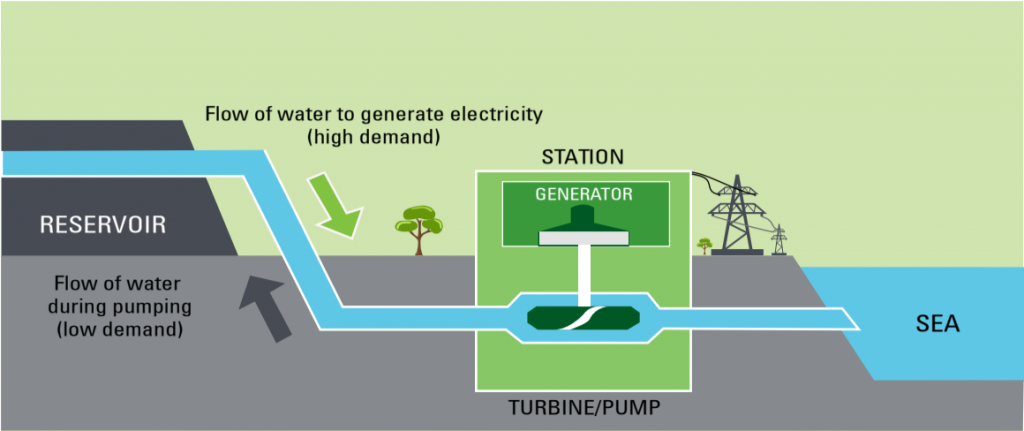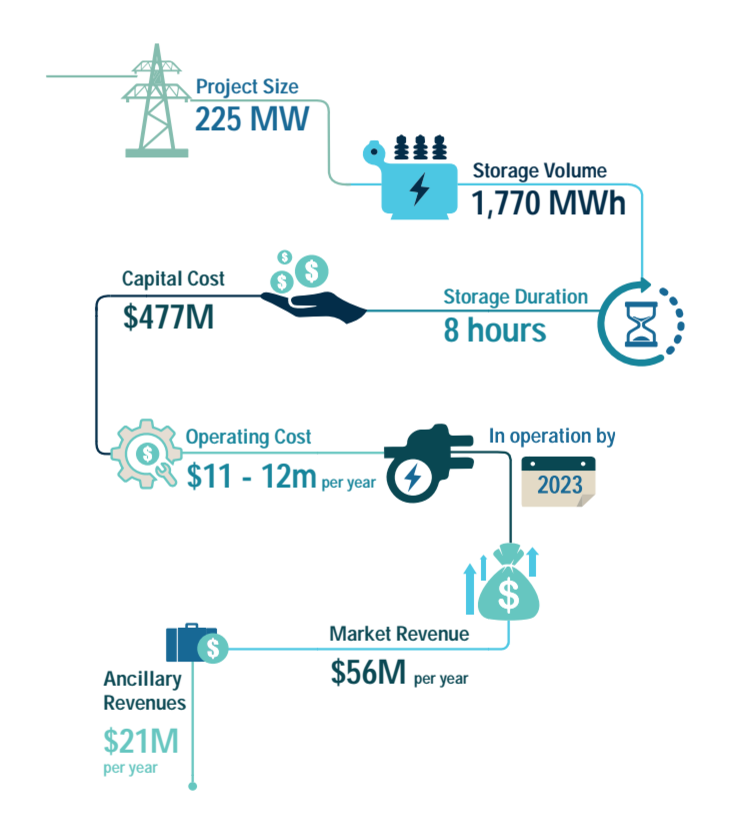Can pumped hydro energy storage work? Let’s sea
Can pumped hydro energy storage work? It’s an idea that could position Australia as a world leader in pumped hydro storage: using sea water as the basis for this established method of generating and storing energy.

Earlier this month, ANU researchers funded by ARENA identified 22,000 sites around Australia suitable for pumped freshwater hydro energy storage. Now, a feasibility study funded by ARENA has examined whether it would be both economically and technically viable to develop a pumped hydro facility that utilises sea water as its storage medium.
If built, the proposed hydro facility – on South Australia’s Spencer Gulf near Port Augusta – would be the only one of its kind anywhere and a total game-changer for mainstreaming renewable energy.
A similar facility was built on the Japanese Island of Okinawa in 1999. Though the technology was considered successful it was dismantled in 2016 because waning demand meant the electricity it supplied was no longer needed.
Why it’s needed
Australia is one of the best sites in the world for generating renewable energy. South Australia has proven particularly proficient, and is already well on track to meet its 2025 target of 50 percent renewable penetration; in fact, the target is likely to be exceeded in the next five years.
However, concerns over reliability of supply and the need to successfully integrate renewables into the grid have the capacity to slow the shift to renewable energy if not successfully addressed. As coal and gas are retired from the state’s electricity network and the share of renewable energy grows it’s important that we create a balanced system that meets the needs and expectations of Australian consumers.
READ MORE: PUMPED HYDRO GURU ANDREW BLAKERS ON HIS NEW RESEARCH
READ MORE: HOW PUMPED HYDRO COULD HELP SOLVE THE STORAGE PROBLEM
That means dispatchable energy resources are needed – those that can be available when they are called upon, to meet bulging demand or to play a role in balancing the system by injecting electricity into the grid.
How it works
Large-scale energy storage will make that possible, and pumped hydro is one of the most proven methods.
In conventional pumped hydro systems, water is stored in two reservoirs. When power supply is high or demand low, excess electricity is used to pump water uphill to the top reservoir (thus ‘charging’ the system). When supply drops or demand is high, the water flows downhill to the lower reservoir, turning a turbine to generate electricity. It’s a simple, high-capacity system with a long asset life.
But in South Australia, suitable fresh water sites – particularly in non-environmentally sensitive areas – are in short supply. That’s where the Cultana Pumped Hydro Project steps in. Using sea water also removes the need for a ‘lower reservoir’. This should help to reduce costs .

The Cultana consortium, made up of Energy Australia, ARUP and University of Melbourne’s Melbourne Energy Institute, has been investigating the feasibility of storing and pumping sea water at the Cultana Training Area.
This site, near the north-western tip of the Spencer Gulf and within view of Port Augusta, fits the bill in a number of ways: a facility here would have good elevation, be close to the coast, close to the grid and wouldn’t have negative effects on environmental or cultural values.
So is it feasible?
The Cultana feasibility study kicked off earlier this year. Granted $453,000 by ARENA, the study set out to discover:
- what size would be best for a pumped sea water hydro project in this area (within the parameters of 100-250MW)
- what it would cost to set up and run the project (within a margin of +/- 30%)
- where the money could come from to build and run the facility
- how much it would cost to connect the facility to the grid
- what issues the project might face with local communities, environmental groups and other stakeholders
- whether market or regulatory changes could affect the project
- whether the project would be technically and economically feasible.
While freshwater pumped hydro is a proven technology, using sea water brings complications and greater costs. Dealing with marine habitats means bigger up-front construction costs, and keeping sea-water-supplied systems clean and uncorroded is more expensive. The study found these problems were surmountable at the site, and that the facility would be technically feasible.
The study found the facility could be in operation by 2023, at an optimal size of 225MW with storage of 1,770MWh. It would cost $477 million up front with running costs of $11-12 million per year. This works out to $2.1 million per MW of capacity, or $270 per KWh of storage. That would be about one-third the cost of equivalent battery storage (these numbers fall within the specified +/- 30 per cent stipulation).

Where would the money come from?
The study consortium found no extraordinary measures would be necessary to fund pumped hydro at the site. Revenue could come from spot price arbitrage on the power generated, selling cap contracts (or hedges against extreme electricity price events), buying non-firm energy from renewable energy suppliers at a fixed price and selling into firm baseload or peak markets at a fixed price, or raising ancillary market revenues (such as supplying inertia, voltage support or system restart services).
The project, were it to be built, would have a post-tax nominal rate of return of 8% to 12%, depending on the revenue assumptions used. In other words, pumped sea water hydro energy storage at Cultana can be considered economically viable in a number of scenarios.
The Cultana consortium is keen to see further work done on the project. They would like to look at an alternative proposal for the facility that could reduce capital costs, and they see potential to further firm up the project costs and revenue potential, particularly given recent developments such as the Finkel Review and the South Australian Government’s Energy Plan.
Whatever this further work discovers, the report from the Cultana Pumped Hydro Project is an extremely promising development for expanding renewable energy generation and transmission in South Australia.
Indeed, there is no reason sea water pumped hydro couldn’t be explored in other sites across Australia, likely with equally positive results. For a country with vast wind and solar resources and limited fresh water, the finding that pumped sea water hydro is both technically and economically viable is encouraging news.
Download the Cultana Pumped Hydro Project Report.
This article was originally written by Jane Rawson, Writer.
LIKE THIS STORY? SIGN UP TO OUR NEWSLETTER

ARENA